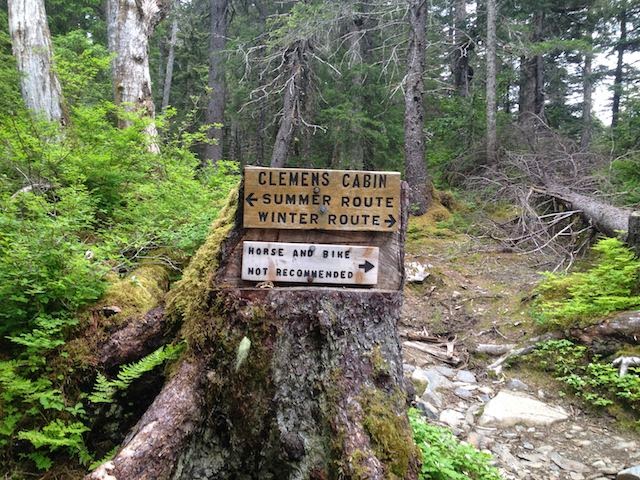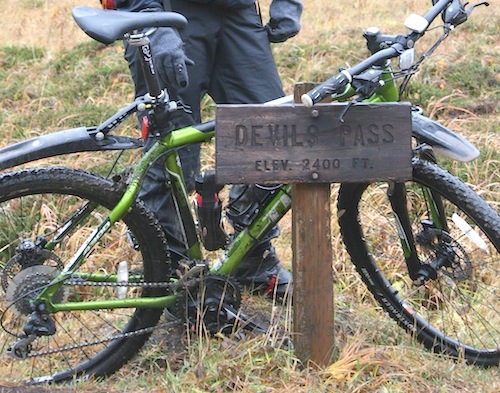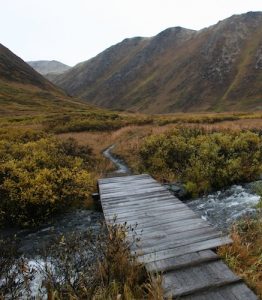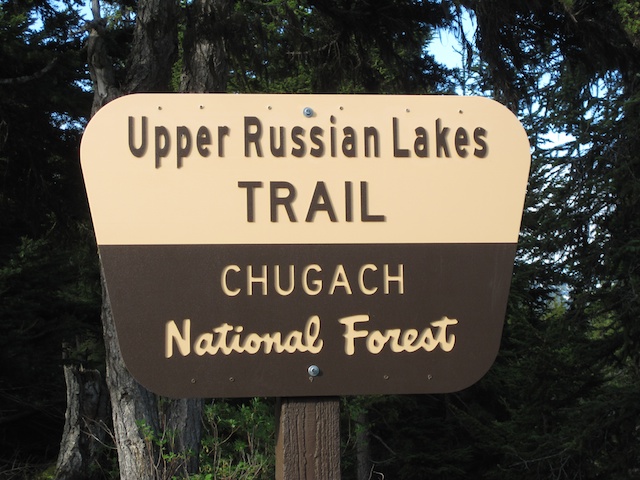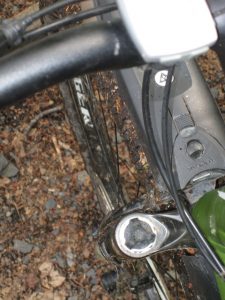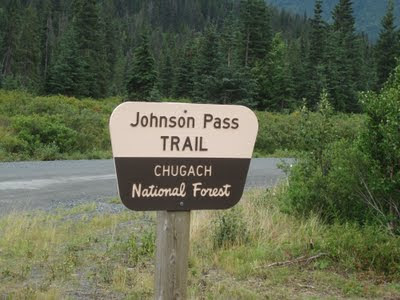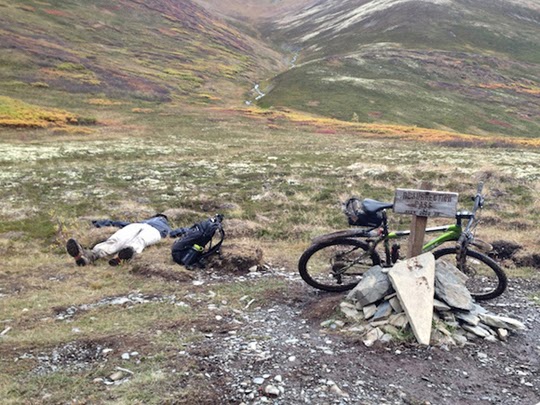 |
| Five minute break—smoke ’em if you’ve got ’em. |
The Big One
I mountain biked Resurrection Pass trail from Hope to Cooper Landing on Saturday. Of all the backcountry trails that you can bike on the Kenai, this is the longest and is certainly a world-class ride. Not particularly technical or steep, just the sheer distance of the trail itself gives a lot of riders reason to put it off. It certainly did for me. I’m happy to report that even with the length, the trail is fairly innocuous. It clocked right at 60 km (37 mi.) on the gps, with wheel spin time coming in at about six hours. If you are in reasonably good shape — you’ll be fine. Just start early and give yourself plenty of time.
From Hope
The usual recommendation is to run the trail north-to-south, even though the rise from either end is exactly the same, starting at an elevation of 400 feet on either end and peaking at 2600 feet at Resurrection Pass. The reason for running from Hope and not Cooper Landing comes from the gradual climb from Hope to the pass — taking back that elevation on the way down mostly in two steep declines, one near Swan Lake, and another just 4 miles from the southern trailhead. After running it, I’d agree wholeheartedly — the climb out of Cooper Landing alone would be fairly rigorous.
The trail/climb from Hope to the pass is fairly kind. The trail is wide and in fairly good condition — the usual rocks, roots, and mud — but mostly wide open. The climb is fairly gentle; the only real exceptions were where the trail dips down to cross a creek or stream. What is a nice run down is paid off with a fairly rigorous climb back out, but just as you think you’ll have to get off and walk it — the trail relents and continues the gentle incline. That continues for just about the first half of the overall trail, almost up the the summit. Once out above tree line (which doesn’t really happen until just a few miles from the summit), the terrain does roll a bit more but still nothing that will make you get off and walk.
Fake out
One thing to note is that once you do emerge from tree line, you’re going to look dead ahead and see what looks like “the T” — and the far side of the valley where Resurrection Trail meets up with Devil’s Creek Trail. Don’t be fooled; what you’re looking at is actually just a continuation of the same valley, with the pass “around the bend” to your right. You will actually have arc to your right a mile or two until you come around almost 45 degrees. At about the point you get to the sign marking the summit, you are looking at the actual far side of the valley where “the T” is. That terrain feature threw me and made the “when are we ever going to get to the summit” part a little tedious.
Back down
The way down comes in roughly three stages. There is a fairly fast (but rocky) run through “the T” and to your right, across the saddle, until you have to climb just a bit before beginning a somewhat technical section down to the valley just below Swan Lake. Next, there is a fairly monotonous run down the valley, past Juneau Lake toward Cooper Landing, on a trail the gradually improves — although it tends to be muddy. (Muddy in an annoying way, not bad enough to do much more than cover your bike in ooze.) The third stretch comes after a cutoff that either runs to the Bean Creek trailhead (straight), or the Juneau Falls route (right) that runs to the trailhead on the Sterling Highway. I’ve taken both, and the Bean Creek run, while a little rougher, is about half the distance. If you take the Juneau Falls run, it winds up and down for most of the roughly five miles — and really only begins its decline within the last mile or so. Generally, the trail is fine, with some annoying sections of rocks and roots here and there.
Water
On this last route, I didn’t pack all the water I needed but brought a UV system to refill as I went. My Steripen failed even with fresh batteries (from what I’ve gathered, this is not an isolated incident), and I had to rely on another party’s “All Clear” UV bottle that Camelbak manufactures. I can’t say enough good about that product — roughly $90 online.
At any rate, there are many places to refill along the way. Be sure to buy some purification drops as a backup in case your UV fails you. The rivers coming straight off the mountain are almost certainly fine, but in the pass itself there are long series of beaver ponds, so anything from there to the trailhead in Cooper Landing will be drawing on that source.
Overgrowth
Resurrection Pass trail is fairly well maintained, and even though I waited for a killing frost to knock down the vegetation, I wouldn’t be afraid to run it earlier in the year. The forests and up above tree line make up almost all of the trail, so the danger of having to snorkel through chest-high wet grass is limited to a very short section (probably a mile). And with the amount of traffic the trail sees, even that shouldn’t be much of a problem.
Data
I’ve attached the .gpx file of the trail taken from the GPS data from this run. (Right click and do the “save as” thing.) Dropbox link for .gpx file.
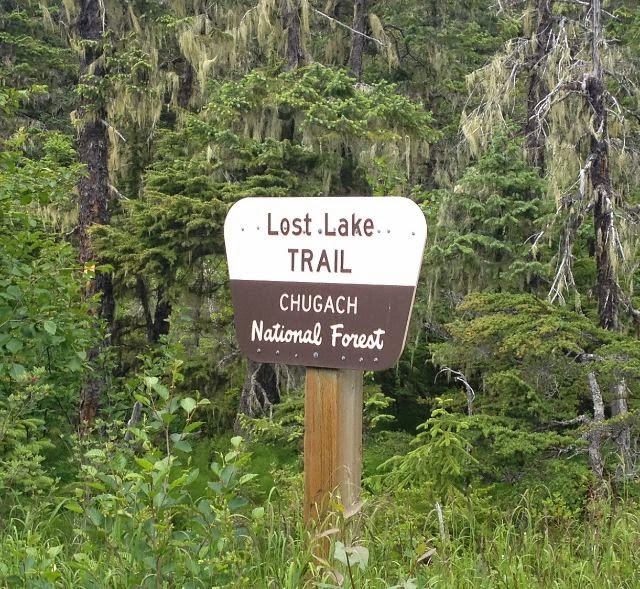 I guess it finally had to happen: mountain biked the Lost Lake and Primrose trails over the weekend, Running north out of Seward, spending the night at Lost Lake, riding out Primrose trail, and then biking back to Seward.
I guess it finally had to happen: mountain biked the Lost Lake and Primrose trails over the weekend, Running north out of Seward, spending the night at Lost Lake, riding out Primrose trail, and then biking back to Seward.